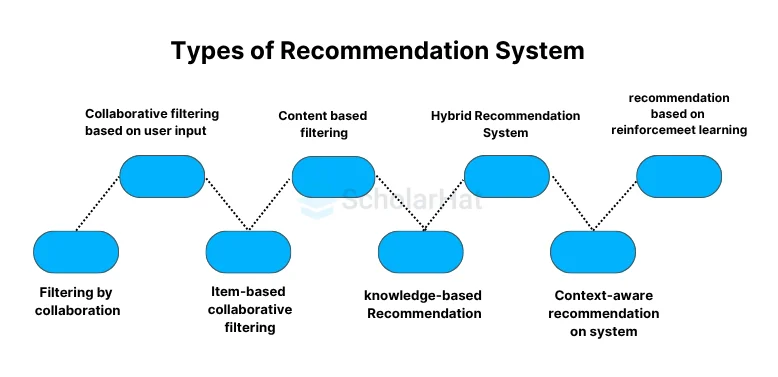21
DecRecommendation Systems in Machine Learning
Recommendation Systems
Introduction
Machine learning must include recommendation systems if it is to provide users with tailored ideas and recommendations. These programs analyze user data and create predictions about their likes and interests using algorithms and other techniques. Recommendation systems can assist users in finding relevant objects, such as films, music, products, and articles, that they are likely to like or find useful by knowing user preferences.
The two main categories of recommendation system in machine learning are collaborative filtering and content-based filtering. To make recommendations, content-based recommendation systems examine the traits and properties of the products. For instance, if a user has expressed interest in action films, the system will suggest other action films depending on how similar their material is. Collaborative filtering recommendation systems, on the other hand, emphasize the preferences and actions of comparable users. Collaborative filtering can recommend products that users with similar tastes have loved by spotting patterns among users with similar interests.
In order to learn from past data and continuously improve their recommendations, recommendation systems rely on machine learning techniques. In order to find patterns and links in the user-item interactions, these systems frequently use methods like matrix factorization, deep learning, and clustering. Recommendation systems can improve their accuracy and offer recommendations that are more individualized by continuously analyzing and responding to user feedback.
There are multiple uses for recommendation systems across numerous sectors. They are used by e-commerce platforms to make relevant product recommendations to customers, boosting sales and elevating customer satisfaction. To encourage user engagement and retention, streaming services utilize recommendation systems to make recommendations for films, TV series, and music that match user preferences. To ensure that visitors receive material that is catered to their interests, news platforms use recommendation systems to give personalized news stories.
It is not easy to create efficient recommendation systems, nevertheless. Significant challenges include dealing with biases and privacy concerns, data scarcity, cold-start issues (where there is little knowledge about new users or goods), and cold-start problems. To overcome these difficulties and enhance the effectiveness of recommendation systems, researchers and practitioners are constantly investigating novel algorithms and methodologies.
Recommendation System
A recommendation system in machine learning is an algorithmic technique that examines user preferences and behaviors to make suggestions for goods or content that the user would find interesting or pertinent. It is a branch of information filtering systems that tries to offer tailored suggestions based on information specific to each user.
A recommendation system in machine learning’s main objectives is to help customers identify products that match their tastes, improve their entire experience, and raise user engagement and happiness. Depending on the setting in which the recommendation system is used, these things could include movies, music, products, articles, books, and more.
Types of Recommendation Systems
Different types of recommendation systems are frequently employed in machine learning. Let's study the primary types:

- Filtering by collaboration: One of the methods used the most frequently in recommendation systems is collaborative filtering. By gathering preferences or behavioral data from a user community, it anticipates a person's interests. Cooperative filtering comes in two flavors:
- Collaborative filtering based on user input: This method finds people who share similar likes and suggests products those users have enjoyed or consumed. It is predicated on the idea that customers with comparable tastes will probably have comparable preferences in the future.
- Item-based Collaborative Filtering: In this method, suggestions are made based on how similar the things are to one another. When two things have received the same number of likes or purchases, they are deemed comparable and one may be suggested to a user who has expressed interest in the other.
- Content-Based Filtering: This method of filtering makes suggestions for products based on the traits or qualities of the products themselves. It proposes comparable items to those that a user has previously shown interest in or interaction with based on an analysis of item attributes like genre, keywords, descriptions, or metadata. The goal of content-based filtering is to match item qualities with user preferences.
- Knowledge-Based Recommendation: Systems that use explicit knowledge or rules to make suggestions are known as knowledge-based recommendation systems. For individualized recommendations, they rely on expert systems or domain-specific knowledge sources. To create suggestions based on user requirements and restrictions, these systems frequently need a clearly defined knowledge representation and reasoning mechanism.
- Hybrid Recommendation Systems: Hybrid recommendation systems integrate many strategies to capitalize on the advantages of each. To deliver more precise and varied recommendations, they combine approaches like collaborative filtering and content-based filtering. Hybrid systems strive to improve recommendation performance by overcoming the drawbacks of individual approaches.
- Context-Aware Recommendation Systems: Context-aware recommendation systems take into account context while producing recommendations, such as time, location, weather, or the user's present position. These systems can offer recommendations that are more pertinent and timelier by adding contextual information. For instance, a system for recommending music can take the user's location into account and suggest songs appropriate for the current weather.
- Recommendation Based on Reinforcement Learning: The optimization of recommendation policies is accomplished through reinforcement learning-based recommendation systems. Users are engaged by the system, and it gains knowledge from their comments as it develops its suggestion method. To maximize user pleasure, the system can employ reinforcement learning to strike a balance between exploration (trying new recommendations) and exploitation (making recommendations based on knowledge already known).
Summary
Recommendation system in machine learning offers customers customized recommendations based on their interests and behaviors. Types of recommendation system can be divided into several forms, such as collaborative filtering, content-based filtering, knowledge-based recommendation, hybrid recommendation systems, context-aware recommendation systems, and reinforcement learning-based recommendation systems.
In order to generate suggestions, collaborative filtering algorithms concentrate on examining user-item interactions and finding commonalities between users or objects. While item-based collaborative filtering proposes comparable items based on the preferences of users who have engaged with them, user-based collaborative filtering suggests items based on the preferences of similar people.
Content-based filtering examines item characteristics like genre, keywords, or descriptions to suggest related products to those in which a consumer has expressed interest. Systems that employ explicit information or rules to provide tailored recommendations based on user needs and restrictions are known as knowledge-based recommendation systems.
To produce more precise and varied recommendations, hybrid recommendation systems incorporate several techniques, including collaborative filtering and content-based filtering. In order to provide recommendations that are more pertinent to the user, context-aware recommendation systems take into account variables including time, location, and user scenario. Systems that employ reinforcement learning to optimize recommendation rules in response to user feedback are known as reinforcement learning-based recommendation systems.
Various businesses, including e-commerce, entertainment, & news platforms, among others, use recommendation algorithms. Building efficient recommendation systems, however, requires tackling issues including data scarcity, cold-start issues, overcoming biases, and privacy concerns.










